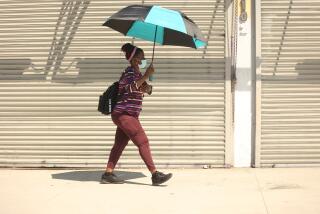As extreme heat bakes California and the West, Biden unveils new plan to respond
- Share via
President Biden announces measures including protections for construction workers, farmers and other laborers who are exposed to sweltering heat.
- Share via
WASHINGTON — As millions of people in California, the Southwest and across the country endured dangerously hot conditions Thursday, President Biden unveiled new measures to help Americans adapt to extreme temperatures.
July is likely to be the hottest month ever recorded on the planet, the United Nations announced Thursday, citing data from its World Meteorological Organization.
In Phoenix, which is on track to become the first major American city to average over 100 degrees for an entire month, some residents are suffering pavement burns from sidewalks. The city has notched at least 27 consecutive days of temperatures 110 degrees Fahrenheit or higher.
“I don’t think anybody can deny the impact of climate change anymore,” Biden said as he sheltered from Washington’s high-90s temperatures in an air-conditioned soundstage near the White House. “Even those who deny we’re in the midst of a climate crisis can’t deny the impact extreme heat is having on Americans.”
Biden announced plans to ask federal regulators to step up enforcement of heat-safety measures to better protect construction workers, farmers and other laborers who are exposed to sweltering temperatures. His administration will also spend $159 million from his infrastructure law and his climate and drug-pricing package to develop better weather forecasting and bolster water storage and climate resilience in California, Colorado and Washington state, he said.
A visit to Death Valley National Park has profound consequences for a veteran of extreme temperature. “I thought I knew heat.”
But Biden’s actions Thursday were limited in scope and aimed at helping Americans adapt to extreme heat. Preventing extreme heat from becoming more common will require a more herculean effort to address climate change, scientists say.
Earlier this week, a study found the extreme heat gripping North America, Europe and Asia in July would have been “virtually impossible” without climate change and increased greenhouse gas emissions, according to researchers at the World Weather Attribution.
“Climate change is here. It is terrifying, and it is just the beginning,” U.N. Secretary-General António Guterres said.
In his remarks, Biden pointed to his Inflation Reduction Act, which included a $400-billion investment in clean energy subsidies, and the Bipartisan Infrastructure Law, which includes billions in subsidies for electric vehicles, as proof of his commitment to tackling the underlying cause of extreme heat.
“Climate change is very real,” White House Press Secretary Karine Jean-Pierre told reporters Thursday. “We have to take serious steps to continue to deal with this issue.”
The extreme heat wave is a worrisome indication of a climate gone haywire as the arrival of El Niño meets with human-caused climate change.
Heat is already the No.1 cause of weather-related deaths in the world, with more than 600 people dying from heat-related illness every year in the U.S., according to the Centers for Disease Control and Prevention.
The measures that Biden announced Thursday are only his latest to boost climate resilience and heat preparedness. The Occupational Safety and Health Administration (OSHA), the agency charged with protecting workers, is drafting a heat standard for workplaces, but the federal rule-making process takes years to complete.
Biden has launched other heat-related initiatives across the administration, including funneling cash through a Department of Health and Human Services program to help lower cooling costs for low-income households. The Department of Energy is helping states to modernize their electric grids, which could allow more Americans to keep their air conditioners running without triggering brownouts. The Environmental Protection Agency has assisted communities in setting up designated spaces within schools so people without air conditioning can cool off.
Last summer, the president unveiled Heat.gov, a website that features a heat tracker, heat index guides and tips to deal with extreme heat for state and local officials.
The administration could still do more to help protect the most vulnerable people from extreme heat, said Kelly Turner, an associate professor of urban planning at the UCLA Luskin School of Public Affairs and co-leader of the Heat Resilient L.A. project.
The campaign — part of Newsom’s $404-million Extreme Heat Action plan — will partner with 121 community-based organizations to conduct outreach in every county.
“You can’t address the problem of rising temperatures without thinking about virtually every policy that affects schools, the workplace, labor, transit — all of those sectors are going to be affected and have rules that need to be revisited,” she said.
The high heat roasting much of the West is only going to continue, according to Turner. In California, at least 100 days out of the calendar year are expected to be extreme heat days, while in other places it could be up to 200 days, she said.
“Every single community should have basic tools like a heat action plan, knowing where their shade infrastructure is and where they need more of it,” Turner said. “That’s going to happen through these sorts of federal investments in local communities.”
Local and state officials in areas that regularly endure heat waves have stepped up efforts to boost heat preparedness. Phoenix Mayor Kate Gallego, who attended Biden’s remarks virtually on Thursday, created the country’s first office of heat response and mitigation in 2021.
We’re “really trying to prepare for what is for us a long-term emergency,” Gallego said during Thursday’s event.
Unusually strong heat waves are becoming more common due to the buildup of greenhouse gases in the atmosphere, researchers say.
Phoenix, Los Angeles and Florida’s Miami-Dade County have all appointed chief heat officers within the last three years, an effort Turner said could be effective at the federal level.
“There’s a lot of knowledge bottled up in places like Los Angeles and Phoenix, which have experienced the weather that other cities are going to be experiencing in the future,” Turner said.
Tackling the problem at the federal level will require exploring the differences among communities. Expanding access to cooling in homes may be more effective in one city or county, whereas directing people to cooling centers that are already set up might be more efficient in another area. Using cooling paint might work in the Southwest, but it might not be effective in places where city officials winterize roads with salt.
“Having somebody who is coordinating and thinking very broadly about those issues is going to be necessary,” Turner added.
More to Read
Get the L.A. Times Politics newsletter
Deeply reported insights into legislation, politics and policy from Sacramento, Washington and beyond. In your inbox twice per week.
You may occasionally receive promotional content from the Los Angeles Times.
















